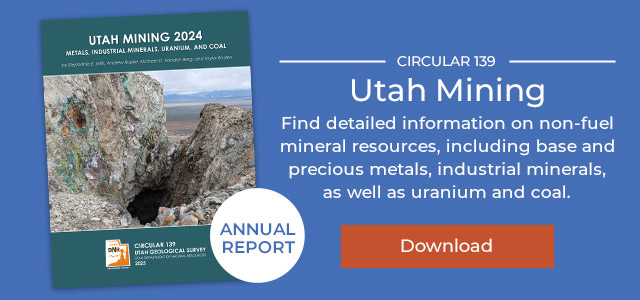Industrial Minerals
Industrial minerals are non-metallic and non-fuel mineral resources. Some of Utah’s significant industrial mineral resources include construction aggregate (sand and gravel and crushed stone), potash, salt (sodium chloride), phosphate, high-calcium limestone, high-magnesium dolomite, uintaite (Gilsonite®), bentonite, and gypsum. See Utah Mining 2024 for statistics on industrial minerals.
Utah’s Industrial Minerals
The information below includes brief descriptions of some of Utah’s industrial mineral resources and helpful references or articles about those resources. If you would like to speak to a geologist about Utah’s industrial minerals, please contact Andrew Rupke at andrewrupke@utah.gov or 801-537-3366. Use the arrows to scroll through Utah’s industrial minerals.
POTASH
Potash is a term for potassium compounds used primarily for fertilizer. Utah produces two types of potash — potassium chloride and potassium sulfate. Utah is one of only two potash-producing states, and the only domestic producer of potassium sulfate. Potash in Utah is produced from Great Salt Lake, the Bonneville Salt Flats, and the Paradox Basin.
Read More
Open-File Report 600 and Appendix
Utah’s Potash Resources and Activity
History of Potash Production
PHOSPHATE
Phosphate rock is used primarily in the production of fertilizer. Utah is one of four phosphate-producing states in the U.S.
Read More
Today’s (and Tomorrow’s?) Phosphate
Circular 66
Bulletin 59
UINTAITE (GILSONITE®)
Uintaite (commonly referred to as Gilsonite®) is a rare, solid hydrocarbon used in diverse applications such as asphalt paving mixes, coatings, ink, paint, and as a drilling fluid additive. Utah is the only state that produces uintaite.
Read More
Special Study 141
Special Study 141 Plate
Contract Report 92-4
HIGH-CALCIUM LIMESTONE
High-calcium limestone is relatively pure limestone used for numerous applications including cement and lime production. Utah has extensive potential resources of high-calcium limestone.
Read More
Special Study 116
Utah Mineral Resources Interactive Map
Utah’s Limestone
Open-File Report 715
Open-File Report 715 database
HIGH-MAGNESIUM DOLOMITE
High-magnesium dolomite is a relatively pure dolomite used for a variety of applications including dolomitic lime and refractory production. Utah has extensive potential resources of high-magnesium dolomite.
Read More
Utah Mineral Resources Interactive Map
Open-File Report 715
Open-File Report 715 database
BUILDING STONE
Building stone is rock that is used in the construction of buildings, retaining walls, bridges, and other structures. Building stone is often cut or split to size for particular applications. The most desirable building stones have a combination of strength, durability, beauty, and ease of quarrying, cutting, and carving.
Read More
Open-File Report 521
Special Study 84
Utah Stone
SALT
The salt mined in Utah is used for a variety of purposes including table salt, road de-icer, and industrial use. Utah has extensive and diverse salt resources, but most of Utah’s produced salt is from Great Salt Lake.
Read More
Great Salt Lake, An Overview of Change
SAND AND GRAVEL AND CRUSHED STONE
Sand and gravel and crushed stone are basic construction raw materials used for road base, asphalt, concrete, and other applications. Sand and gravel is sourced from relatively recent, unconsolidated deposits and crushed stone is sourced from bedrock deposits.
POTASH
Potash is a term for potassium compounds used primarily for fertilizer. Utah produces two types of potash — potassium chloride and potassium sulfate. Utah is one of only two potash-producing states, and the only domestic producer of potassium sulfate. Potash in Utah is produced from Great Salt Lake, the Bonneville Salt Flats, and the Paradox Basin.
Read More
Open-File Report 600 and Appendix
Utah’s Potash Resources and Activity
History of Potash Production
PHOSPHATE
Phosphate rock is used primarily in the production of fertilizer. Utah is one of four phosphate-producing states in the U.S.
Read More
Today’s (and Tomorrow’s?) Phosphate
Circular 66
Bulletin 59
UINTAITE (GILSONITE®)
Uintaite (commonly referred to as Gilsonite®) is a rare, solid hydrocarbon used in diverse applications such as asphalt paving mixes, coatings, ink, paint, and as a drilling fluid additive. Utah is the only state that produces uintaite.
Read More
Special Study 141
Special Study 141 Plate
Contract Report 92-4
HIGH-CALCIUM LIMESTONE
High-calcium limestone is relatively pure limestone used for numerous applications including cement and lime production. Utah has extensive potential resources of high-calcium limestone.
Read More
Special Study 116
Utah Mineral Resources Interactive Map
Utah’s Limestone
Open-File Report 715
Open-File Report 715 database
HIGH-MAGNESIUM DOLOMITE
High-magnesium dolomite is a relatively pure dolomite used for a variety of applications including dolomitic lime and refractory production. Utah has extensive potential resources of high-magnesium dolomite.
Read More
Utah Mineral Resources Interactive Map
Open-File Report 715
Open-File Report 715 database
BUILDING STONE
Building stone is rock that is used in the construction of buildings, retaining walls, bridges, and other structures. Building stone is often cut or split to size for particular applications. The most desirable building stones have a combination of strength, durability, beauty, and ease of quarrying, cutting, and carving.
Read More
Open-File Report 521
Special Study 84
Utah Stone
SALT
The salt mined in Utah is used for a variety of purposes including table salt, road de-icer, and industrial use. Utah has extensive and diverse salt resources, but most of Utah’s produced salt is from Great Salt Lake.
Read More
Great Salt Lake, An Overview of Change
SAND AND GRAVEL AND CRUSHED STONE
Sand and gravel and crushed stone are basic construction raw materials used for road base, asphalt, concrete, and other applications. Sand and gravel is sourced from relatively recent, unconsolidated deposits and crushed stone is sourced from bedrock deposits.
Industrial Mineral Resources
Highlighted Scientific Publications
Circular 139
Utah Mining 2024—Metals, Industrial Minerals, Uranium, and Coal
Circular 135
Critical Minerals of Utah, Second Edition
Special Study 141
Gilsonite veins of the Uinta Basin, Utah
Open-File Report 730
Lithium Brine Analytical Database of Utah
Attached Data
Open-File Report 715
Carbonate (Limestone and Dolomite) Analytical Database of Utah
Attached Data
Open-File Report 600
Well Database and Maps of Salt Cycles and Potash Zones of the Paradox Basin, Utah
Attached Data
Public Interest Articles
Please select a column to search in.
Please type in something to search for.
- 1
- 2
Industrial Mineral Articles: 65













